
The Munich U-Bahn is an electric rail rapid transit network in Munich, Germany. The system began operation in 1971, and is operated by the municipally owned Münchner Verkehrsgesellschaft. The network is integrated into the Münchner Verkehrs- und Tarifverbund and interconnected with the Munich S-Bahn. The U-Bahn currently comprises eight lines, serving 96 stations, and encompassing 103.1 kilometres (64.1 mi) of routes.

Bogenhausen is the 13th borough of Munich, Germany. It is the geographically largest borough of Munich and comprises the city's north-eastern quarter, reaching from the Isar on the eastern side of the Englischer Garten to the city limits, bordering on Unterföhring to the north, Aschheim to the east and the Haidhausen borough to the south.

Maillingerstraße is a street in the Munich districts of Maxvorstadt and Neuhausen. Running from north to south, it connects Nymphenburger Straße with Marsstraße. It is named after the Bavarian general and Minister of War Joseph Maximilian von Maillinger. The street has been named Maillingerstraße since 1886. Today Maillingerstraße is a traffic calmed secondary road.

Ludwigsvorstadt-Isarvorstadt is one of the boroughs of Munich, Germany.

Neuhausen and Nymphenburg were boroughs of Munich, the capital of the German state of Bavaria. They were merged into the borough 09 - Neuhausen-Nymphenburg in 1992. For further information on the Munich boroughs, see: Boroughs of Munich.

The Dachauer Straße is the longest street in Munich with a length of 11.2 km and it received its name since it is the connecting road to Dachau Palace. In the north of Munich, it is part of the Bundesstraße 304.
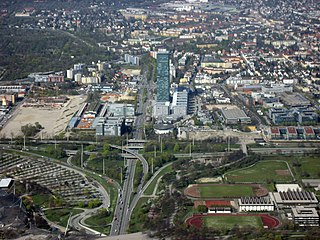
Moosach is the 10th northwestern district of Munich, Bavaria, Germany. It is sectioned in the urban districts Hartmannshofen, Pressestadt and Borstei.

Sendlinger Straße is an important shopping street in Munich's city center. It extends into the Munich old town in the south-east-northeast direction from the Sendlinger Tor in the west to the point where Fürstenfelder Straße and the Rindermarkt meet in the east. In July 2016, the conversion from a one-way street into a pedestrian zone was attempted.
The Sonnenstraße is a street in the city center of Munich. It forms the border between the city districts Altstadt and Ludwigsvorstadt.

The Hofstatt is a shopping mall that opened in 2013 in Munich's old town. The core of the building is the former site of the Süddeutscher Verlag, whose historical edifices are part of the design by architect Max Littmann on the Sendlinger Straße and the brick printing press building was also incorporated into the project.
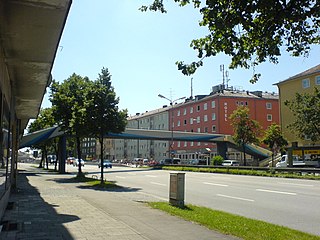
The Tegernseer Landstraße is a street in the Obergiesing borough of Munich, Germany, which runs in a southeastern direction and is a total of 4.6 kilometers long. It begins in the north as a straight extension of the Regerstraße, where it is a regular two-lane road until the Tegernseer Platz. At the Tegernseer Platz, a large branch of the Deutsche Post can be found. The building, nicknamed Tela-Post, was built in 1928 in the architectural style New Objectivity. The Hertie-store, which was located at the Tegernseer Platz until the summer of 2009, was closed because of insolvency and demolished in 2010. Between 1976 and 2016, a branch of the city library was located across the street. There are efforts to strengthen the local economy and prevent vacancy of retail spaces around the Tegernseer Landstraße, which are funded by the federal government.

The Stammstrecke 2 of the Munich U-Bahn is one of three main routes in the subway network of the Bavarian capital Munich. It runs from north to south, as well as east, and is currently operated by the underground U1 and U2 lines. Since 12 December 2011, the U7 line runs during high traffic times and since 15 December 2013 the U8 line assists on Saturdays. The U1 and U2 lines only run together on one route, in the central inner city area, before and after that, they are branched away from each other. The main line 2 has a total length of 33.8 kilometers and 38 underground stations. It runs exclusively in the city of Munich and completely in the tunnel.
Lothstraße is a roughly 1.3 kilometer long street in Munich. It runs through the St. Benno district and forms the boundary between the municipality of Maxvorstadt, which lies southeast of the street, and the districts of Neuhausen and Schwabing-West, which are located northwest.

The Arnulfstraße is a 3.8 km long urban street in Munich. It leads from the Bahnhofplatz in the Ludwigsvorstadt through the Maxvorstadt west to Romanplatz in Neuhausen. Over the Hackerbrücke, there is a connection to the Landsberger Straße, which runs parallel to the south of the railway tracks. Until 1983, the tram line 3 drove through the Arnulfstraße. It was initially diverted in the course of the Munich S-Bahn construction and then shut down. In 1996, the tram service was reopened on the Arnulfstraße with the line number 17.
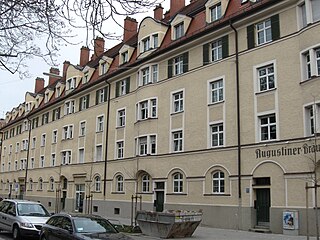
The Bergmannstraße is a street in Munich and lies west of the city center. It leads from Landsberger Straße in the north to Ridlerstraße in the south and is located in the district of Schwanthalerhöhe. The formerly referred to as Sendlinger way road, was named in 1883 after the lawyer, historian and archivist Michael Adam von Bergmann (1733-1783), who was city chief judge starting in 1762 and then became mayor in Munich.
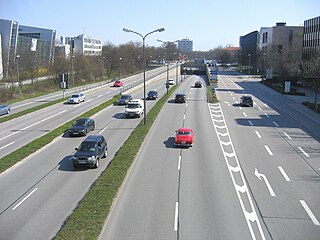
The Schenkendorfstraße is a four- to ten-lane section of the Mittlerer Ring in Munich.

The Landsberger Straße is one of the main arterial roads in Munich.

The Trappentreustraße is a street in the west of Munich and part of the Mittlerer Ring.
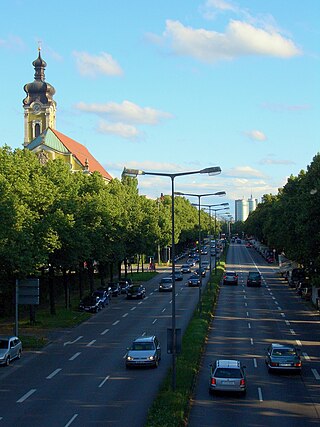
The Landshuter Allee is an avenue in Munich and through most of its course it is part of the Mittlerer Ring, the Bundesstraße 2 R. It joins Donnersbergerbrücke at Arnulfstraße in the Neuhausen district and runs from Dachauer Straße west of the Olympiapark to Moosacher Straße west of the Olympic village in the Moosach district. The B 2R leaves the intersection-free avenue at the Landshuter Allee and continues on the Georg-Brauchle-Ring. The Landshuter Allee now functions as the B 304 and connects the Mittlerer Ring with the northern tangent of the Outer Ring, which is only partially complete. The large width of the Landshuter Allee of 54 metres between the houses is striking. It crosses the Nymphenburg-Biedersteiner Kanal.

Leonrodplatz is a square in the Munich district of Neuhausen. It was named in 1927 after the former Bavarian Minister of Justice Leopold von Leonrod.



















